
The eastern brown snake, often referred to as the common brown snake, is a species of extremely venomous snake in the family Elapidae. The species is native to eastern and central Australia and southern New Guinea. It was first described by André Marie Constant Duméril, Gabriel Bibron, and Auguste Duméril in 1854. The adult eastern brown snake has a slender build and can grow to 2 m (7 ft) in length. The colour of its surface ranges from pale brown to black, while its underside is pale cream-yellow, often with orange or grey splotches. The eastern brown snake is found in most habitats except dense forests, often in farmland and on the outskirts of urban areas, as such places are populated by its main prey, the house mouse. The species is oviparous. The International Union for Conservation of Nature classifies the snake as a least-concern species, though its status in New Guinea is unclear.

The red-bellied black snake is a species of venomous snake in the family Elapidae, indigenous to Australia. Originally described by George Shaw in 1794 as a species new to science, it is one of eastern Australia's most commonly encountered snakes. Averaging around 1.25 m in length, it has glossy black upperparts, bright red or orange flanks, and a pink or dull red belly. It is not aggressive and generally retreats from human encounters, but can attack if provoked. Although its venom can cause significant illness, no deaths have been recorded from its bite, which is less venomous than other Australian elapid snakes. The venom contains neurotoxins, myotoxins, and coagulants and has haemolytic properties. Victims can also lose their sense of smell.
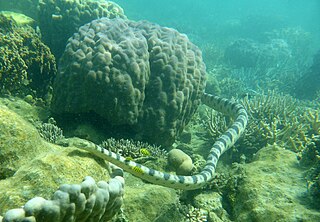
The olive-headed sea snake, also known as the greater sea snake, is a species of venomous sea snake in the family Elapidae.

The king brown snake is a species of highly venomous snake of the family Elapidae, native to northern, western, and Central Australia. The king brown snake is the largest terrestrial venomous snake in Australia. Despite its common name, it is a member of the genus Pseudechis and only distantly related to true brown snakes. Its alternative common name is the mulga snake, although it lives in many habitats apart from mulga. First described by English zoologist John Edward Gray in 1842, it is a robust snake up to 3.3 m (11 ft) long. It is variable in appearance, with individuals from northern Australia having tan upper parts, while those from southern Australia are dark brown to blackish. Sometimes, it is seen in a reddish-green texture. The dorsal scales are two-toned, sometimes giving the snake a patterned appearance. Its underside is cream or white, often with orange splotches. The species is oviparous. The snake is considered to be a least-concern species according to the International Union for Conservation of Nature, though may have declined with the spread of the cane toad.
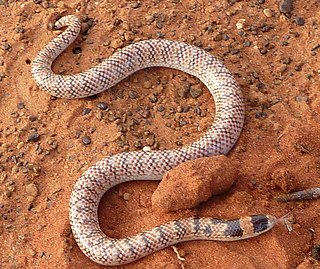
Simoselaps, or Australian coral snakes, is a genus composed of 12 species of venomous elapid snakes.

Brachyurophis is a genus of elapid snakes known as shovel-nosed snakes, so named because of their shovel-nosed snout which is used to burrow. The genus has eight recognized species, which are all found in Australia.

The prong-snouted blind snake is a species of non-venomous worm-like burrowing snakes belonging to the Typhlopidae family. It is endemic to central southern, continental Australia.
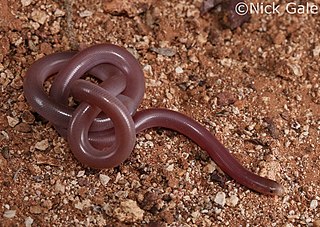
Anilios endoterus is commonly known as the interior blind snake. It is one of 42 species of snake in the genus Anilios (Ramphotyphlops) from the Typhlopidae family living in Australia. These snakes appear to be blind, having vestigial eyes that are extremely sensitive to light. It is a cryptic burrowing snake that lives in tunnels underground, living mainly on a diet of ants. They are found in arid and semi-arid desert regions of central Australia and are considered endangered in New South Wales (NSW).
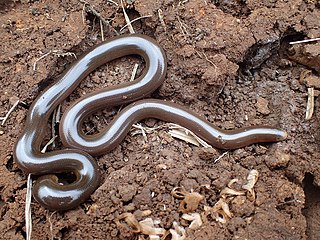
Bibron's blind snake is a species of snake in the family Typhlopidae. The species is native to southern Africa.
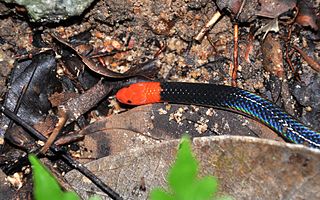
Calamaria schlegeli is a species of snake in the family Colubridae. The species is known commonly as the red-headed reed snake, white-headed reed snake, and pink-headed reed snake. It is native to Southeast Asia, where it occurs in Brunei, Indonesia, Malaysia, and Singapore.

The western brown snake is commonly known as Mengden's brown snake, and alternatively, gwardar.

The strap-snouted brown snake is a species of venomous snake in the family Elapidae. The species is native to South Australia, New South Wales, Queensland, and Victoria. P. aspidorhyncha is part of a species complex that also includes P. mengdeni and P. nuchalis; all were formerly included in the latter species.

Brachyurophis fasciolatus is a species of snake from the family Elapidae, commonly named the narrow-banded shovel-nosed snake, or narrow-banded burrowing snake, and is a species endemic to Australia. Its common names reflect its shovel nose specialization, burrowing behaviour and banded body colour.
The ghost skink is a species of skink endemic to Australia.
Brachyurophis incinctus is a species of snake from the family Elapidae, commonly named the unbanded shovel-nosed snake, and is a species endemic to Australia. Its common name reflects its shovel nose specialisation, burrowing behaviour and the fact that it is not banded on its body.
Brachyurophis approximans, also known as the north-western shovel-nosed snake, is a species of mildly venomous burrowing snake that is endemic to Australia. The specific epithet approximans (“approaching”) alludes to its similarity to Brachyurophis campbelli.
Brachyurophis campbelli, also known as the Cape York shovel-nosed snake or Einasliegh shovel-nosed snake, is a species of mildly venomous burrowing snake that is endemic to Australia. The specific epithet campbelli honours a Mr W.D. Campbell who collected the type specimen in 1928 in the vicinity of Almaden, Queensland.
Brachyurophis roperi, also known as the northern shovel-nosed snake, is a species of mildly venomous burrowing snake that is endemic to Australia. The specific epithet roperi refers to the type locality of the Roper River Mission in the Northern Territory. It was formerly considered a subspecies of Brachyurophis semifasciatus.
Brachyurophis morrisi, also known as the Arnhem shovel-nosed snake, is a species of mildly venomous burrowing snake that is endemic to Australia. The specific epithet morrisi honours author and naturalist Ian James Morris for his contributions to knowledge of the animals of the Northern Territory, who first collected the species in 1970.
Cacophis harriettae, also known commonly as Harriett's snake, the white-crowned snake, and the white-naped snake, is a species of mildly venomous snake in the family Elapidae. The species is endemic to Australia.













